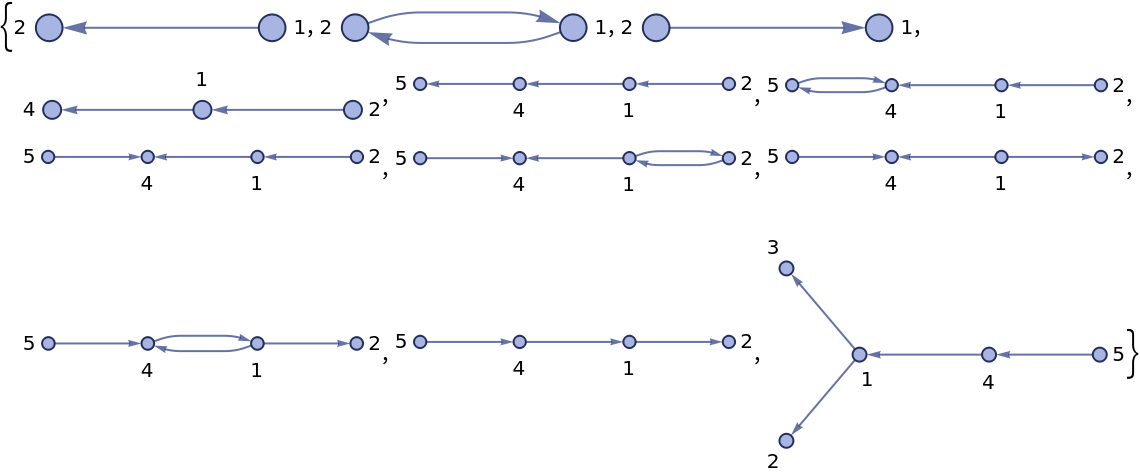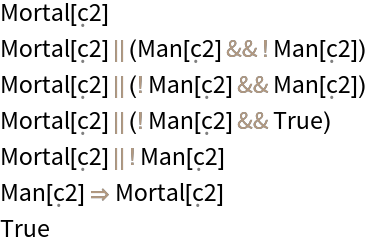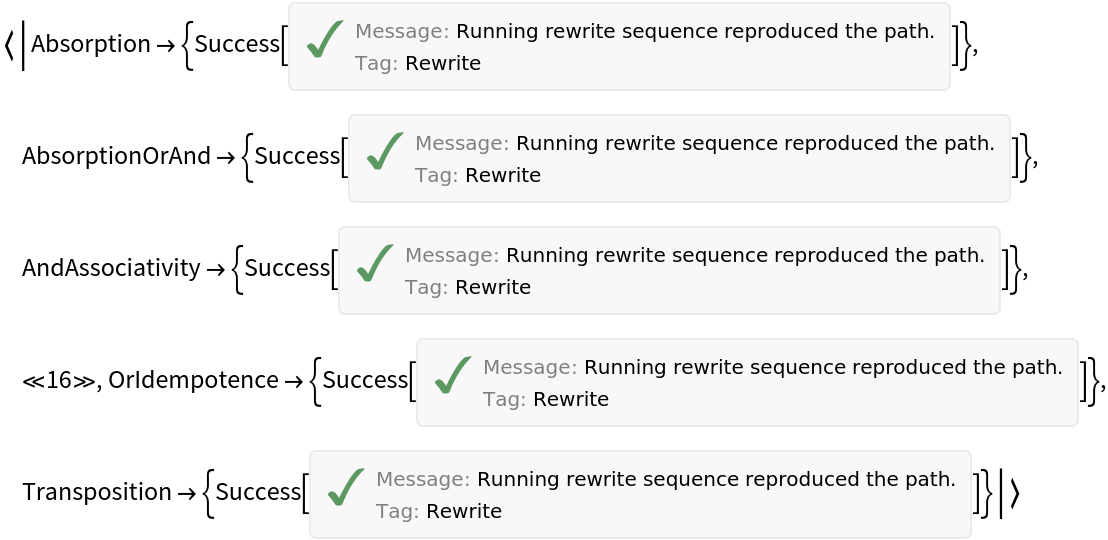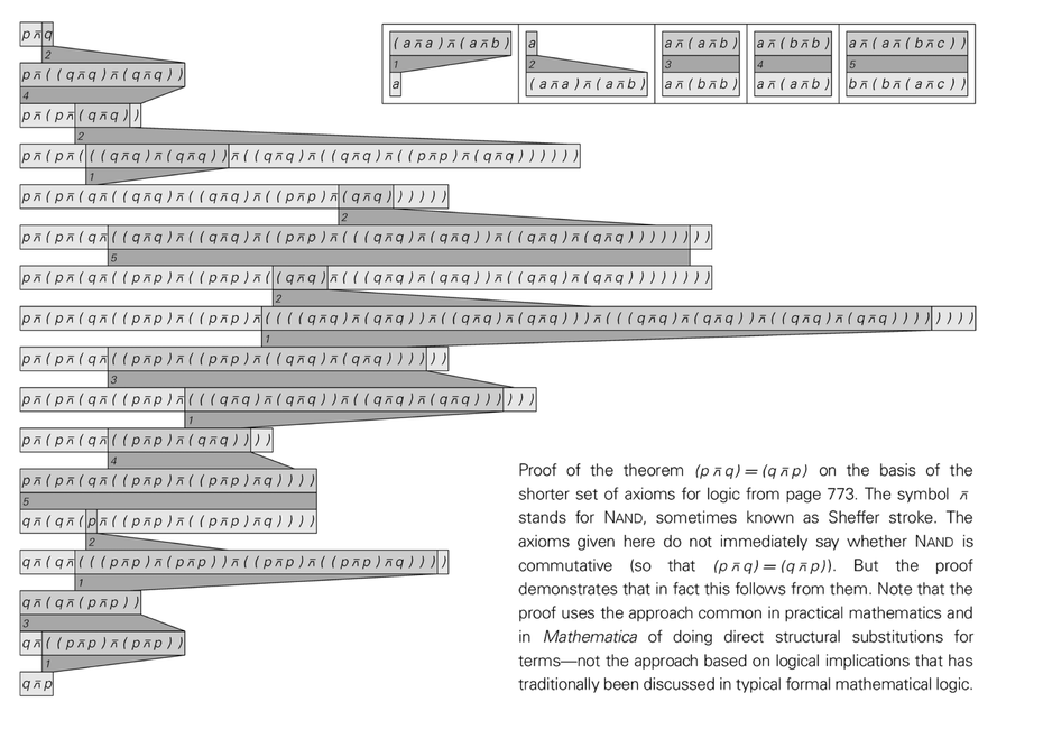Details and Options
ResourceFunction["FindEquationalPath"] uses
FindEquationalProof to find a proof of equational proposition and by using cut-elimination, derives a sequential path of one-step replacements from one side of a theorem to another.
The replacement path consists of pattern expressions corresponding to logic formulas with patterns (like a
Blank,
a_) representing universal variables (
ForAll) and other symbols representing functional constants (
Exists).
Properties prop supported by ResourceFunction["FindEquationalPath"] include:
| "ProofObject" | the corresponding ProofObject |
| "Path" | a list of expressions comprising a found path (default) |
| "Justification" | a list of axioms used in each subsequent step of a path together with its orientation and position |
| "Rewrites" | a list of rewriting functions that reproduce a path |
| "RewritesTest" | test rewriting functions to successfully reproduce a path |
| All | all of the above as an association |
For the "Justification" property, axiom orientation is a direction of a corresponding rule, for example a==b can be used as a → b (right orientation) or b → a (left orientation).
Position of a step is a position of a subexpression at which a rule corresponding to an axiom is being applied.
Explicit hypothesis and conclusion lemmas are keys from the "Proof" or "ProofDataset" properties of a
ProofObject, with {"Hypothesis", 1} and corresponding {"Conclusion", 1} being the default.
Explicit conclusion lemma is rarely needed, it is used as a starting point to generate a path by backtracking through a proof graph.
ResourceFunction["FindEquationalPath"] takes the option
"Reverse". With
"Reverse"→True, a reversed replacement path is returned.
![ResourceFunction["FindEquationalPath"][
ForAll[{x, y}, plus[x, plus[y, 0]] == plus[x, plus[0, y]]], {ForAll[x, plus[x, 0] == x], ForAll[x, plus[x, neg[x]] == 0], ForAll[{x, y, z}, plus[plus[x, y], z] == plus[x, plus[y, z]]]}]](https://www.wolframcloud.com/obj/resourcesystem/images/4ed/4edacf77-2fd1-4637-8b86-b025f3d037d7/1-0-0/33039448d49ad38c.png)
![ResourceFunction["FindEquationalPath"][
ForAll[{a, b}, or[not[or[not[a], b]], not[or[not[a], not[b]]]] == a], {ForAll[{a, b}, and[a, b] == and[b, a]], ForAll[{a, b}, or[a, b] == or[b, a]], ForAll[{a, b}, and[a, or[b, not[b]]] == a], ForAll[{a, b}, or[a, and[b, not[b]]] == a], ForAll[{a, b, c}, and[a, or[b, c]] == or[and[a, b], and[a, c]]], ForAll[{a, b, c}, or[a, and[b, c]] == and[or[a, b], or[a, c]]]}] // Short](https://www.wolframcloud.com/obj/resourcesystem/images/4ed/4edacf77-2fd1-4637-8b86-b025f3d037d7/1-0-0/2256b79de093dcf1.png)



![ResourceFunction["WolframModelPlot"][#, VertexLabels -> Automatic] & /@
Reverse[
First /@ Gather[Sort /@ (List /@ ResourceFunction["FindEquationalPath"][
proof] /. {CircleMinus | CirclePlus | CircleTimes -> List, CircleDot -> Sequence})]
]](https://www.wolframcloud.com/obj/resourcesystem/images/4ed/4edacf77-2fd1-4637-8b86-b025f3d037d7/1-0-0/3a434e284d936f33.png)



![AssociationMap[
ResourceFunction["FindEquationalPath"][#, "BooleanAxioms", All][
"RewriteTest"] & /@ AxiomaticTheory["BooleanAxioms", "NotableTheorems"][#] &, Keys@AxiomaticTheory["BooleanAxioms", "NotableTheorems"]] // Short](https://www.wolframcloud.com/obj/resourcesystem/images/4ed/4edacf77-2fd1-4637-8b86-b025f3d037d7/1-0-0/67c122515b751cae.png)


![proof = FindEquationalProof[p\[CenterDot]q == q\[CenterDot]p, {\!\(
\*SubscriptBox[\(\[ForAll]\), \(\[FormalA]\)]\(\((\[FormalA]\[CenterDot]\[FormalA])\)\[CenterDot]\((\[FormalA]\[CenterDot]\[FormalA])\)\)\) \[Implies] \[FormalA], \!\(
\*SubscriptBox[\(\[ForAll]\), \({\[FormalA], \[FormalB]}\)]\(\[FormalA] == \((\[FormalA]\[CenterDot]\[FormalA])\)\[CenterDot]\((\[FormalA]\[CenterDot]\[FormalB])\)\)\), \!\(
\*SubscriptBox[\(\[ForAll]\), \({\[FormalA], \[FormalB]}\)]\(\[FormalA]\[CenterDot]\((\[FormalA]\[CenterDot]\[FormalB])\) == \[FormalA]\[CenterDot]\((\[FormalB]\[CenterDot]\[FormalB])\)\)\), \!\(
\*SubscriptBox[\(\[ForAll]\), \({\[FormalA], \[FormalB], \[FormalC]}\)]\(\((\[FormalA]\[CenterDot]\((\[FormalA]\[CenterDot]\((\[FormalB]\[CenterDot]\[FormalC])\))\))\) == \((\[FormalB]\[CenterDot]\((\[FormalB]\[CenterDot]\((\[FormalA]\[CenterDot]\[FormalC])\))\))\)\)\)}]](https://www.wolframcloud.com/obj/resourcesystem/images/4ed/4edacf77-2fd1-4637-8b86-b025f3d037d7/1-0-0/0dd9f4aef0160b8e.png)


![ResourceFunction["FindEquationalPath"][
Exists[{p, q}, p\[CenterDot]q == q\[CenterDot]p], {\!\(
\*SubscriptBox[\(\[ForAll]\), \(\[FormalA]\)]\(\((\[FormalA]\[CenterDot]\[FormalA])\)\[CenterDot]\((\[FormalA]\[CenterDot]\[FormalA])\)\)\) \[Implies] \[FormalA], \!\(
\*SubscriptBox[\(\[ForAll]\), \({\[FormalA], \[FormalB]}\)]\(\[FormalA] == \((\[FormalA]\[CenterDot]\[FormalA])\)\[CenterDot]\((\[FormalA]\[CenterDot]\[FormalB])\)\)\), \!\(
\*SubscriptBox[\(\[ForAll]\), \({\[FormalA], \[FormalB]}\)]\(\[FormalA]\[CenterDot]\((\[FormalA]\[CenterDot]\[FormalB])\) == \[FormalA]\[CenterDot]\((\[FormalB]\[CenterDot]\[FormalB])\)\)\), \!\(
\*SubscriptBox[\(\[ForAll]\), \({\[FormalA], \[FormalB], \[FormalC]}\)]\(\((\[FormalA]\[CenterDot]\((\[FormalA]\[CenterDot]\((\[FormalB]\[CenterDot]\[FormalC])\))\))\) == \((\[FormalB]\[CenterDot]\((\[FormalB]\[CenterDot]\((\[FormalA]\[CenterDot]\[FormalC])\))\))\)\)\)}]](https://www.wolframcloud.com/obj/resourcesystem/images/4ed/4edacf77-2fd1-4637-8b86-b025f3d037d7/1-0-0/6367fa10c3a11060.png)